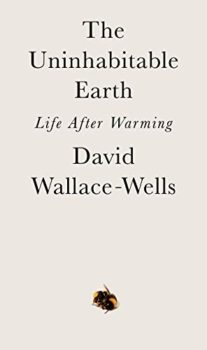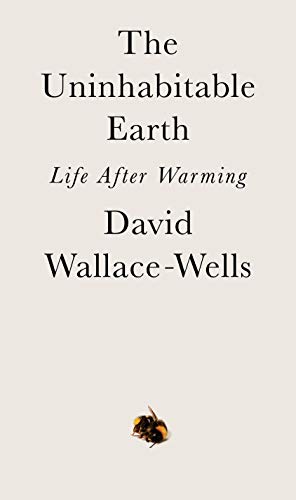
They’ve been lying to us. Or, better put, shading the truth. And I’m not referring to the climate deniers in the Trump White House and Congress. We know they’re lying. The problem is, the scientists who have been warning us about climate change aren’t telling the whole truth. In fact, that bad habit is so widespread there’s even a name for it: scientific reticence. The reality is, climate change is worse than you think—much, much worse. And the only place I’ve found the whole story laid out in plain English is in an eloquent new book by David Wallace-Wells, The Uninhabitable Earth. This truly extraordinary book should be must reading for every elected official at any level of government throughout the United States.
Estimated reading time: 7 minutes
The 2-degree limit is unrealistic
If you’ve been paying even the slightest attention to the news about global warming, you know that nearly all the public discussion about the topic revolves around limiting the temperature increase to either 1.5 or 2 degrees Celsius by 2100. (One degree Celsius equals 1.8 degrees Fahrenheit.) Unfortunately, given any reasonable scenario about human efforts to reduce carbon emissions, it’s highly unlikely the 2-degree limit can be held. In fact, as Wallace-Wells makes clear, an increase of 3 or 4 degrees by the end of the century seems unavoidable. The best-case scenario is now somewhere between 2 and 2.5 degrees of warming by 2100—and that depends on the fulfillment of all the pledges of the Paris Agreement (which no single advanced nation is currently achieving).
The Uninhabitable Earth: Life After Warming by David Wallace-Wells (2019) 304 pages ★★★★★
Climate change is worse than you think—much, much worse
Now, you may be thinking, what can be the harm from a difference of one or two, even three degrees? Sadly, an increase of that magnitude would be catastrophic. Wallace-Wells spells out the top-line effects our children and grandchildren can expect by 2100 in such chapter titles as these: Heat Death, Hunger, Drowning, Wildfire, Freshwater Drain, Dying Oceans, Unbreathable Air, Plagues of Warming, Economic Collapse, and Climate Conflict. As Wallace-Wells notes, “the world has, at most, about three decades to completely decarbonize before truly devastating climate horrors begin.”
For example, as the author noted in an interview with Vox.com, “by the end of the century we could be seeing roughly 64 times as much land burned every year as we saw in 2018, a year that felt completely unprecedented and inflicted unimaginable damage in California.” Not to mention the psychological damage those fires inflicted on tens of thousands of people who were evacuated from fire zones. And to put all this in perspective, consider this: “In California,” Wallace-Wells observes, “a single wildfire can entirely eliminate the emissions gains made that year by all of the state’s aggressive environmental policies. Fires of that scale happen every year now.”
Many of the world’s great cities will be underwater
Much of the limited media coverage of climate change focuses on rising sea levels. Certainly, it’s important to understand that many of the world’s great cities are destined to be under water if current trends continue—and, quite possibly, sooner rather than later. Sixty percent of the world’s population lives within 100 miles of the oceans. And the seas might well rise far faster than anyone expected even a few years ago. For example, “the Greenland ice sheet could reach a tipping point at just 1.2 degrees of global warming. (We are nearing that temperature level today, already at 1.1 degrees.)” And “the last time the earth was four degrees warmer . . . there was no ice at either pole and sea level was 260 feet higher. There were palm trees in the Arctic. Better not to think what that means for life at the equator.” Better, indeed!
But the danger of flooding is not limited to coastal cities: rivers and lakes will flood, too. “Without flood adaptation measures, large swaths of northern Europe and the whole eastern half of the United States will be affected by at least ten times as many floods.” And the damage will be much worse in such flood-prone areas as Southeast Asia. In fact, you don’t have to look much further than the American Midwest to understand what’s coming.
“Suffering beyond anything that humans have ever experienced”
“Warming of 3 or 3.5 degrees,” writes Wallace-Wells, “would unleash suffering beyond anything that humans have ever experienced through many millennia of strain and strife and all-out war. But it is not a fatalistic scenario; in fact, it’s a whole lot better than where we are headed.” And, unfortunately, the steps we are taking to mitigate the problem are far, far too small. For instance, he notes, the mining of Bitcoin today “consumes more electricity than is generated by all the world’s solar panels combined.” And in “Germany, where so much nuclear power has recently been retired[, . . .] the country is growing its carbon emissions despite a state-of-the-world energy program.” As the saying goes, two steps forward, one step back. Or is that one step forward, two back?
Surprising consequences of increased CO2 levels
Wallace-Wells writes about what he calls cascades, which are essentially the unintended (and often unforeseen) consequences of seemingly simple developments that prove to be complex indeed. For example, he cites “a dramatic effect of carbon dioxide on human nutrition unanticipated by plant physiologists: [increased CO2] can make plants bigger, but those bigger plants are less nutritious.” The upshot is that over the past half-century the level of such elements of nutrition as protein, calcium, iron, and vitamin C has decreased by as much as one-third. “Even the protein content of bee pollen has dropped by a third.” And nutritional declines of this sort are occurring across the board—including in rice, the staple food of more than half the world’s population.
Wallace-Wells sums it up nicely: “Eating organic is nice . . . but if your goal is to save the climate your vote is much more important.”
About the author
“I am not an environmentalist, and don’t even think of myself as a nature person,” the author writes. “I’ve lived my whole life in cities, enjoying gadgets built by industrial supply chains I hardly think twice about. I’ve never gone camping, not willingly anyway, and while I always thought it was basically a good idea to keep streams clean and air clear, I also always accepted the proposition that there was a trade-off between economic growth and cost to nature—and figured, well, in most cases I’d probably go for growth.” Clearly, then, David Wallace-Wells is no environmental extremist. In fact, The Uninhabitable Earth is the result of interviews with dozens of scientists “and from hundreds of papers published in the best academic journals over the previous decade or so.”
Wallace-Wells’s bio on Amazon reads, “David Wallace-Wells is a national fellow at the New America foundation and a columnist and deputy editor at New York magazine. He was previously the deputy editor of The Paris Review. He lives in New York City.”
For related reading
You’ll find this book in good company on my post, Good books about climate change. Included are these in particular:
- Scatter, Adapt, and Remember: How Humans Will Survive a Mass Extinction by Annalee Newitz (Will the human race survive climate change and a mass extinction?)
- Hot: Living Through the Next Fifty Years on Earth by Mark Hertsgaard (Global warming and climate change: the next fifty years)
- The Sixth Extinction: An Unnatural History by Elizabeth Kolbert (Are we living through the Sixth Extinction?)
- Flight Behavior by Barbara Kingsolver (Barbara Kingsolver writes eloquently about climate change)
I’ve also written a brief essay about the historical perspective on the subject at What history teaches us about climate change.
This is one of the books I’ve included in my post, Gaining a global perspective on the world around us.
Also, check out Science explained in 10 excellent popular books and 20 good nonfiction books about the future (plus lots of science fiction).
And you can always find my most popular reviews, and the most recent ones, on the Home Page.


























